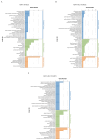Aloperine Inhibits ASFV via Regulating PRLR/JAK2 Signaling Pathway In Vitro
- PMID: 39201769
- PMCID: PMC11354989
- DOI: 10.3390/ijms25169083
Aloperine Inhibits ASFV via Regulating PRLR/JAK2 Signaling Pathway In Vitro
Abstract
African swine fever (ASF) has become a global pandemic due to inadequate prevention and control measures, posing a significant threat to the swine industry. Despite the approval of a single vaccine in Vietnam, no antiviral drugs against the ASF virus (ASFV) are currently available. Aloperine (ALO), a quinolizidine alkaloid extracted from the seeds and leaves of bitter beans, exhibits various biological functions, including anti-inflammatory, anti-cancer, and antiviral activities. In this study, we found that ALO could inhibit ASFV replication in MA-104, PK-15, 3D4/21, and WSL cells in a dose-dependent manner without cytotoxicity at 100 μM. Furthermore, it was verified that ALO acted on the co- and post-infection stages of ASFV by time-of-addition assay, and inhibited viral internalization rather than directly inactivating the virus. Notably, RT-qPCR analysis indicated that ALO did not exert anti-inflammatory activity during ASFV infection. Additionally, gene ontology (GO) and KEGG pathway enrichment analyses of transcriptomic data revealed that ALO could inhibit ASFV replication via the PRLR/JAK2 signaling pathway. Together, these findings suggest that ALO effectively inhibits ASFV replication in vitro and provides a potential new target for developing anti-ASFV drugs.
Keywords: African swine fever virus; JAK2 signaling pathway; PRLR; aloperine; transcriptomics.
Conflict of interest statement
The authors declare no conflicts of interest.
Figures








Similar articles
-
Bis-benzylisoquinoline alkaloids inhibit African swine fever virus internalization and replication by impairing late endosomal/lysosomal function.J Virol. 2024 Aug 20;98(8):e0032724. doi: 10.1128/jvi.00327-24. Epub 2024 Jul 31. J Virol. 2024. PMID: 39082785 Free PMC article.
-
African Swine Fever Virus Envelope Glycoprotein CD2v Interacts with Host CSF2RA to Regulate the JAK2-STAT3 Pathway and Inhibit Apoptosis to Facilitate Virus Replication.J Virol. 2023 Apr 27;97(4):e0188922. doi: 10.1128/jvi.01889-22. Epub 2023 Apr 6. J Virol. 2023. PMID: 37022174 Free PMC article.
-
Resveratrol inhibits African swine fever virus replication via the Nrf2-mediated reduced glutathione and antioxidative activities.Emerg Microbes Infect. 2025 Dec;14(1):2469662. doi: 10.1080/22221751.2025.2469662. Epub 2025 Mar 3. Emerg Microbes Infect. 2025. PMID: 39964001 Free PMC article.
-
Antiviral agents against African swine fever virus.Virus Res. 2019 Sep;270:197669. doi: 10.1016/j.virusres.2019.197669. Epub 2019 Jul 17. Virus Res. 2019. PMID: 31325472 Review.
-
Structure of African Swine Fever Virus and Associated Molecular Mechanisms Underlying Infection and Immunosuppression: A Review.Front Immunol. 2021 Sep 6;12:715582. doi: 10.3389/fimmu.2021.715582. eCollection 2021. Front Immunol. 2021. PMID: 34552586 Free PMC article. Review.
Cited by
-
Punicalagin Inhibits African Swine Fever Virus Replication by Targeting Early Viral Stages and Modulating Inflammatory Pathways.Vet Sci. 2024 Sep 19;11(9):440. doi: 10.3390/vetsci11090440. Vet Sci. 2024. PMID: 39330819 Free PMC article.
References
-
- Zhang R., Huang Y., Bao C., Jung Y., Xu J., Qian Y. Epidemiology of African swine fever and analysis of risk factors of its spread in China: An overview. Chin. J. Virol. 2019;35:512–522.
MeSH terms
Substances
Grants and funding
LinkOut - more resources
Full Text Sources
Miscellaneous

